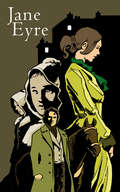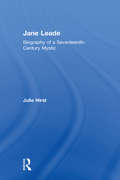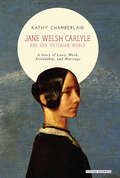- Table View
- List View
Jane Boleyn: The Infamous Lady Rochford
by Julia FoxJane Rochford was sister-in-law to Anne Boleyn and Lady of the Bedchamber to Katherine Howard, whom she followed to the scaffold in 1542. Hers is a life of extraordinary drama as a witness to and participant in the greatest events of Henry's reign. She arrived at court as a teenager when Katherine of Aragon was queen. Even before Henry's marriage to Anne, her own marriage to George Boleyn brought her into the closest royal circles - and there she remained through the unfolding spectacle and tragedy of Henry's succession of marriages. She survived the trauma of Anne and George's executions and despite briefly being banned from Court managed to regain her place there to attend on Jane Seymour and Anne of Cleves. Her supposed part in both Anne Boleyn's and Katherine Howard's downfall has led to her being reviled through centuries. In this fascinating biography Julia Fox repudiates the idea of the infamous Lady Rochford and Jane emerges as a rather modern woman forced by brutal circumstance to fend for herself in a politically lethal world.
Jane Boleyn: The Infamous Lady Rochford
by Julia FoxThe story of Henry VIII's queens - as seen through the eyes of Jane Rochford, sister-in-law to Anne Boleyn and cousin to Katherine Howard.'Outstanding ... fascinating and moving' Amanda Foreman, bestselling author of THE DUCHESSJane Rochford was sister-in-law to Anne Boleyn and Lady of the Bedchamber to Katherine Howard, whom she followed to the scaffold in 1542. Hers is a life of extraordinary drama as a witness to, and participant in, the greatest events of Henry's reign.She arrived at court as a teenager when Katherine of Aragon was queen. Even before Henry's marriage to Anne, her own marriage to George Boleyn brought her into the closest royal circles - and there she remained through the unfolding spectacle and tragedy of Henry's succession of marriages. She survived the trauma of Anne and George's executions and despite briefly being banned from Court managed to regain her place there to attend on Jane Seymour and Anne of Cleves. Her supposed part in both Anne Boleyn's and Katherine Howard's downfall has led to her being reviled through centuries.In this fascinating biography Julia Fox repudiates the idea of the infamous Lady Rochford and Jane emerges as a rather modern woman forced by brutal circumstance to fend for herself in a politically lethal world.
Jane Campion (Routledge Film Guidebooks)
by Deb VerhoevenJane Campion is one of the most celebrated auteurs of modern cinema and was the first female director to be awarded the prestigious Palme d'Or. Throughout her relatively short career, Campion has received extraordinary attention from the media and scholars alike and has provoked fierce debates on issues such as feminism, colonialism, and nationalism. In this detailed account of Jane Campion's career as a filmmaker, Deb Verhoeven examines specifically how contemporary film directors 'fashion' themselves as auteurs – through their personal interactions with the media, in their choice of projects, in their emphasis on particular filmmaking techniques and finally in the promotion of their films. Through analysis of key approaches to Campion's films, such as The Piano; In the Cut; Sweetie; An Angel at My Table; and Holy Smoke Deb Verhoeven introduces students to the passionate debates surrounding this controversial and often experimental director Featuring a career overview, a filmography, scene by scene analysis and an extended interview with Campion on her approach to creativity, this is a great introduction to one of the most important directors of contemporary cinema.
Jane Eyre
by Charlotte BronteOrphaned at an early age, Jane Eyre survives an unhappy childhood at the grim Lowood School. Despite Jane's deprived background, her intelligence and courage earn her a position as a governess at the imposing home of Mr Rochester. Overcoming her sense that all at Thornfield Hall is not as it seems, Jane finds herself becoming fond of her new life. But she finds it increasingly hard to maintain her composure. As her cautious friendship with her often moody master deepens, Jane opens herself up to the possibility of happiness at last. But Thornfield Hall conceals secrets that are conspiring against their happiness.
Jane Eyre
by Charlotte BronteJane begins life penniless and plain: an unlikely romantic heroine. But she is as indomitable in spirit as she is frail in appearance. Taking a position as a governess at Thornfield Hall, her relationship with her employer, the enigmatic Mr Rochester intensifies, until she is forced to choose between the desires of her heart and the demands of a 'moral' society.(P)1995 Hodder & Stoughton Audiobooks
Jane Eyre
by Charlotte BrontëA masterpiece of nineteenth-century English Literature, Charlotte Bronte's Jane Eyre follows the titular character as she attempts to rise from humble beginnings to find independence and love. Jane is a passionate and intelligent woman who struggles in life until she secures the job as governess for the wealthy, kind Edward Rochester. At Thornfield Hall, Rochester's estate, Jane finds herself falling for her employer, and though the feelings are reciprocated, Rochester also has a terrible secret that threatens their future together. Jane Eyre is not only a classic romance, but has been praised for its penetrating depiction of Jane's inner moral and intellectual struggles, and is still read widely to this day.
Jane Eyre's Daughter
by Elizabeth NewarkA passionate young woman of high courage... IN THIS SEQUEL TO JANE EYRE, young Janet Rochester is consigned to Highcrest Manor and the guardianship of the strict Colonel Dent while her parents journey to the West Indies. As Janet struggles to make a life for herself, guided by the ideals of her parents, she finds herself caught up in the mysteries of Highcrest. Why is the East Wing forbidden to her? What lies behind locked gates? And what is the source of the voices she hears in the night? Can she trust the enigmatic Roderick Landless, or should she transfer her allegiance to the suave and charming Sir Hugo Calendar? Whether riding her mare on the Yorkshire moors, holding her own with Colonel Dent, or waltzing at her first ball, Janet is strong, sympathetic, and courageous. After all, she is her mother's daughter... "THE VERY FIRST SCENE PULLED ME IN AND THE SUSPENSE CONTINUED TO BUILD TO THE VERY END. I'M VERY IMPRESSED!" - Historical-Fiction.com
Jane Eyre: An Autobiography (Norton Critical Editions Ser. #0)
by Charlotte Bronte<p>Initially published under the pseudonym Currer Bell in 1847, Charlotte Brontë’s <i>Jane Eyre</i> erupted onto the English literary scene, immediately winning the devotion of many of the world’s most renowned writers, including William Makepeace Thackeray, who declared it a work “of great genius.” <p>Widely regarded as a revolutionary novel, Brontë’s masterpiece introduced the world to a radical new type of heroine, one whose defiant virtue and moral courage departed sharply from the more acquiescent and malleable female characters of the day. <p>Passionate, dramatic, and surprisingly modern, <i>Jane Eyre</i> endures as one of the world’s most beloved novels.</p>
Jane Eyre: An Autobiography (Seasons Series)
by Charlotte BronteA fine exclusive edition of one of literature&’s most beloved stories with full page call-outs with quotes from summer.It was quiet at the other end of the house; but I knew my way; and the light of the unclouded summer moon, entering here and there at passage windows, enabled me to find it without difficulty.Throughout the hardships of her childhood, Jane Eyre clings to a sense of self-worth, despite the maltreatment from those close to her. At the age of eighteen, sick of her narrow existence, Jane seeks work as a governess. The monotony of her new life at Thornfield Hall is derailed by the arrival of her peculiar and volatile employer, Mr. Rochester.A flagship of Victorian fiction, Jane Eyre intrigues readers through the vigorous courage of Jane's voice, a forceful depiction of childhood injustice, an unflinching examination of the restraints placed upon women, and a worthy exploration into the complexities of both faith and passion.Jane Eyre (Seasons Edition--Summer) is one of four titles available in June 2020. The summer season also will include The Adventures of Huckleberry Finn, Persuasion, and The Wonderland Collection.
Jane Eyre: Illustrations By Marjolein Bastin (Marjolein Bastin Classics Ser.)
by Charlotte BronteJane Eyre is the inspiring heroine of one of the best-loved British novels of all time. As an orphan, Jane's childhood is not an easy one but her independence and strength of character keep her going through the miseries inflicted by cruel relatives and a brutal school. However, her biggest challenge is yet to come. Taking a job as a governess in a house full of secrets, for a passionate man she grows more and more attracted to, ultimately forces Jane to call on all her resources in order to hold on to her beliefs.
Jane Eyre: Teacher's Book
by Charlotte BronteA masterpiece of nineteenth-century English Literature, Charlotte Bronte's Jane Eyre follows the titular character as she attempts to rise from humble beginnings to find independence and love. <P><P>Jane is a passionate and intelligent woman who struggles in life until she secures the job as governess for the wealthy, kind Edward Rochester. At Thornfield Hall, Rochester's estate, Jane finds herself falling for her employer, and though the feelings are reciprocated, Rochester also has a terrible secret that threatens their future together. Jane Eyre is not only a classic romance, but has been praised for its penetrating depiction of Jane's inner moral and intellectual struggles, and is still read widely to this day.
Jane Goodall
by Bardhan-Quallen SudiptaUp Close: Jane Goodall by Sudipta Bardhan-Quallen Up Close: Thurgood Marshall by Chris Crowe A trailblazing scientist made famous by her favorite primates. Jane Goodall will forever be linked with the chimpanzees that she?s studied for over fifty years. A pioneer in scientific research, she revolutionized longstanding views about chimps, forest conservation, and women in scientific fields. This Up Close biography tells the story of how a demure young woman from London went to Africa and changed the world. .
Jane Grey Swisshelm: An Unconventional Life, 1815-1884
by Sylvia D. HoffertNineteenth-century newspaper editor Jane Grey Swisshelm (1815-1884) was an unconventionally ambitious woman. While she struggled in private to be a dutiful daughter, wife, and mother, she publicly critiqued and successfully challenged gender conventions that restricted her personal behavior, limited her political and economic opportunities, and attempted to silence her voice. As the owner and editor of newspapers in Pittsburgh; St. Cloud, Minnesota; and Washington, D.C.; and as one of the founders of the Minnesota Republican Party, Swisshelm negotiated a significant place for herself in the male-dominated world of commerce, journalism, and politics. How she accomplished this feat; what expressive devices she used; what social, economic, and political tensions resulted from her efforts; and how those tensions were resolved are the central questions examined in this biography. Sylvia Hoffert arranges the book topically, rather than chronologically, to include Swisshelm in the broader issues of the day, such as women's involvement in politics and religion, their role in the workplace, and marriage. Rescuing this prominent feminist from obscurity, Hoffert shows how Swisshelm laid the groundwork for the "New Woman" of the turn of the century.
Jane Haining: A Life of Love and Courage
by Mary MillerA &“very moving biography&” of a courageous woman who gave her life in order to stay with her orphaned students during the Nazi invasion of Hungary (Scotsman). A farmer&’s daughter from Scotland, Jane Haining went to work at the Scottish Jewish Mission School in Budapest in 1932, where she was a boarding school matron in charge of around fifty orphan girls. Jane was back in the UK on holiday when war broke out in 1939, but she immediately went back to Hungary to do all she could to protect the four hundred children at the school, most of them Jewish. She refused to leave in 1940, and again ignored orders to flee the country in March 1944 when Hungary was invaded by the Nazis. She remained with her pupils, writing &“if these children need me in days of sunshine, how much more do they need me in days of darkness.&” Her brave persistence led to her arrest by the Gestapo in April 1944, for &“offenses&” that included spying, working with Jews, and listening to the BBC. She died in the Nazi concentration camp at Auschwitz just a few months later, at the age of forty-seven. This story of her courage and self-sacrifice, her choice to stay and protect the children in her care, is &“an inspiring tale of quiet heroism&” (Neil MacGregor). &“Haining&’s firm moral compass emerges clearly, making her story heroic as well as heart-rending. Materially, she may have left little behind, but her legacy is enduring.&” —Church Times
Jane Hope
by Elizabeth Janet GrayJane Hope was twelve when her mother, a widow, returned with her children to live in her father's house at Chapel Hill, North Carolina. Jane dreamed of the excitement of living in a college town, of romance with herself as the heroine. Jane was always helping out some stray or other, from dogs, cats to people, and it was Stephen Farthing whom she rescued who later fell in love with her. This is a story of life at Chapel Hill just before the Civil War.
Jane Jacobs: Champion of Cities, Champion of People
by Rebecca PittsThe first biography of Jane Jacobs for young people, the visionary activist, urbanist, and thinker who transformed the way we inhabit and develop our cities.Jane Jacobs was born more than a hundred years ago, yet the ideas she popularized—about cities, about people, about making a better world—remain hugely relevant today. Now, in Jane Jacobs: Champion of Cities, Champion of People, we have the first biography for young people of the visionary activist, urbanist, and thinker.Debut author Rebecca Pitts draws on archives and Jacobs&’s own writings to paint a vivid picture of a headstrong and principled young girl who grew into one of the most important advocates of her time, and whose impact on the city of New York in particular can still be seen today. Jacobs went against the conventional wisdom of the time that said cities should be designed by so-called experts, &“cleaned up,&” and separated by use, arguing that such pie-in-the-sky visions paid very little attention to the wants and needs of people who actually live in cities. Jane instead championed diversity, community, &“the life of the street,&” and the power of grassroots movements to make cities better and more equitable for all. She never backed down, even when it meant going up against the most powerful man in New York, Robert Moses.Here is a story of standing up for what you know is right, with real-world takeaways for young activists. Jane Jacobs: Champion of Cities, Champion of People emphasizes how today&’s teens can take inspiration from Jane&’s own activism &“playbook,&” promoting change by focusing on local issues and community organizing.
Jane Leade: Biography of a Seventeenth-Century Mystic
by Julie HirstJane Leade (1624-1704) is probably the most prolific woman writer and most important female religious leader in late seventeenth-century England, yet, she still remains relatively unknown. By exploring her life and works as a prophetess and mystic, this books opens a fascinating window into the world of a remarkable woman living in a remarkable age. Born in Norfolk into a gentry family, Jane Leade enjoyed a comfortable childhood, married a distant cousin, who was a merchant, and had four children. However, she found herself totally destitute in London when he died, his fortune having been lost abroad. As a widow, she proclaimed herself to be a `Bride of Christ', and eventually became a prolific author and a respected blind, elderly leader of a religious group of well-educated men and women, known as the Philadelphian Society. The structure of this book is informed by the chronological events that happened during her life and is complemented by examining some of the material she published, including her visions of the Virgin Wisdom, or Sophia. She started writing in 1670, but published prolifically in the 1680s and 1690s, and this material offers a fascinating glimpse into the mind of an extraordinary woman. Believing herself to be living in the `End Times' she expected Sophia would return with the second coming of Christ. The Philadelphian Society grew under her charge, until they were buffeted by mobs in London. Jane Leade died in her eighty-first year and is buried in the non-conformist cemetery, Bunhill Fields, in London. By contextualising her and drawing out the nature of her devotions this new book draws attention to her as a figure in her own right. Previous studies have tended to reduce her to one example within a certain tradition, but as this work clearly demonstrates she was in fact a much more complicated character who did not conform to any one particular tradition.
Jane Seymour, The Haunted Queen: A Novel (Six Tudor Queens #3)
by Alison WeirAcclaimed author and historian Alison Weir continues her epic Six Tudor Queens series with this third captivating novel, which brings to life Jane Seymour, King Henry VIII’s most cherished bride and mother of his only legitimate male heir. Ever since she was a child, Jane has longed for a cloistered life as a nun. But her large noble family has other plans, and as an adult, Jane is invited to the King’s court to serve as lady-in-waiting to Queen Katherine of Aragon. The devout Katherine shows kindness to all her ladies, almost like a second mother, which makes rumors of Henry’s lustful pursuit of Anne Boleyn—also lady-in-waiting to the queen—all the more shocking. For Jane, the betrayal triggers memories of a hauntingl incident that shaped her beliefs about marriage. But once Henry disavows Katherine and secures Anne as his new queen—forever altering the religious landscape of England—he turns his eye to another: Jane herself. Urged to return the King’s affection and earn favor for her family, Jane is drawn into a dangerous political game that pits her conscience against her desires. Can Jane be the one to give the King his long-sought-after son, or will she be cast aside like the women who came before her? Bringing new insight to this compelling story, Alison Weir marries meticulous research with gripping historical fiction to re-create the dramas and intrigues of the most renowned court in English history. At its center is a loving and compassionate woman who captures the heart of a king, and whose life will hang in the balance for it. Praise for Anne Boleyn, A King’s Obsession “A stunning, engaging, comprehensive and convincing novel . . . important, page-turning biographical fiction, hauntingly and beautifully told in first-person narrative . . . psychologically penetrating and packed with wonderful, vivid scenes. [Alison] Weir’s characterisation is superb.”—Historical Novels Review “A persuasive attempt to restore the humanity of a tragic, misrepresented figure . . . Weir’s fictional Anne is ferociously smart and guilty of nothing but craving the power that’s rightfully hers to claim.”—NPR “A richly detailed rendering of the familiar Tudor drama . . . Weir brings considerable expertise to her portrait of Anne as ‘a flawed but very human heroine, a woman of great ambition, idealism and courage’ [and] vividly depicts court life.”—Kirkus Reviews “A multifaceted portrait of an ambitious woman . . . Even readers who know Anne’s story well should gain insights from this revealing novel.”—Booklist “Well-written and fast-paced . . . a fresh look at one of the period’s most popular protagonists.”—Library Journal
Jane Seymour: An Illustrated Life
by Carol-Ann JohnstonBiography of the third wife of King Henry VIII of England, and the mother of Edward VI who was Henry's only son. Jane Seymour is the wife of Henry VIII we know the least about, often written off as ‘Plain Jane’. Queen of England for just seventeen months, during her life Jane witnessed some of the most extraordinary events ever to take place in English history, later becoming a part of them. Jane ensured her place in Henry’s affections by giving him his much longed-for male heir only to tragically lose her life twelve days later leaving behind a motherless son and a devastated husband. For the remainder of his life Henry would honor the mother of his only legitimate son and would come to regard Jane as his ‘true and loving wife’. But who was Jane Seymour? Throughout this illustrated book we will find a woman who was neither saint or sinner, but a human being with her own beliefs and causes.
Jane Steele
by Lyndsay Faye“Reader, I murdered him.”<P><P> A sensitive orphan, Jane Steele suffers first at the hands of her spiteful aunt and predatory cousin, then at a grim school where she fights for her very life until escaping to London, leaving the corpses of her tormentors behind her. After years of hiding from the law while penning macabre “last confessions” of the recently hanged, Jane thrills at discovering an advertisement. Her aunt has died and her childhood home has a new master: Mr. Charles Thornfield, who seeks a governess.<P> Burning to know whether she is in fact the rightful heir, Jane takes the position incognito and learns that Highgate House is full of marvelously strange new residents—the fascinating but caustic Mr. Thornfield, an army doctor returned from the Sikh Wars, and the gracious Sikh butler Mr. Sardar Singh, whose history with Mr. Thornfield appears far deeper and darker than they pretend. As Jane catches ominous glimpses of the pair’s violent history and falls in love with the gruffly tragic Mr. Thornfield, she faces a terrible dilemma: Can she possess him—body, soul, and secrets—without revealing her own murderous past? <P> A satirical romance about identity, guilt, goodness, and the nature of lies, by a writer who Matthew Pearl calls “superstar-caliber” and whose previous works Gillian Flynn declared “spectacular,” Jane Steele is a brilliant and deeply absorbing book inspired by Charlotte Brontë’s classic Jane Eyre.
Jane Steele
by Lyndsay Faye'Reader, I murdered him.' JANE STEELE is a brilliant Gothic retelling of JANE EYRE from Edgar-nominated Lyndsay Faye, for fans of LONGBOURN and PRIDE AND PREJUDICE AND ZOMBIES. 'I loved it' - Elly Griffiths.** JANE STEELE HAS BEEN NOMINATED FOR AN EDGAR AWARD FOR BEST NOVEL 2017 **Like the heroine of the novel she adores, Jane Steele suffers cruelly at the hands of her aunt and schoolmaster. And like Jane Eyre, they call her wicked - but in her case, she fears the accusation is true. When she flees, she leaves behind the corpses of her tormentors. A fugitive navigating London's underbelly, Jane rights wrongs on behalf of the have-nots whilst avoiding the noose. Until an advertisement catches her eye. Her aunt has died and the new master at Highgate House, Mr Thornfield, seeks a governess. Anxious to know if she is Highgate's true heir, Jane takes the position and is soon caught up in the household's strange spell. When she falls in love with the mysterious Charles Thornfield, she faces a terrible dilemma: can she possess him - body, soul and secrets - and what if he discovers her murderous past?
Jane Steele
by Lyndsay Faye'Reader, I murdered him.' JANE STEELE is a brilliant Gothic retelling of JANE EYRE from Edgar-nominated Lyndsay Faye, for fans of LONGBOURN and PRIDE AND PREJUDICE AND ZOMBIES. 'I loved it' - Elly Griffiths.** JANE STEELE HAS BEEN NOMINATED FOR AN EDGAR AWARD FOR BEST NOVEL 2017 **Like the heroine of the novel she adores, Jane Steele suffers cruelly at the hands of her aunt and schoolmaster. And like Jane Eyre, they call her wicked - but in her case, she fears the accusation is true. When she flees, she leaves behind the corpses of her tormentors. A fugitive navigating London's underbelly, Jane rights wrongs on behalf of the have-nots whilst avoiding the noose. Until an advertisement catches her eye. Her aunt has died and the new master at Highgate House, Mr Thornfield, seeks a governess. Anxious to know if she is Highgate's true heir, Jane takes the position and is soon caught up in the household's strange spell. When she falls in love with the mysterious Charles Thornfield, she faces a terrible dilemma: can she possess him - body, soul and secrets - and what if he discovers her murderous past?(P)2016 Headline Digital
Jane Welsh Carlyle and Her Victorian World: A Story of Love, Work, Marriage, and Friendship
by Kathy Chamberlain&“Intelligent, witty, thoroughly engaging . . . the most fascinating biography I have read in years.&” —The Minneapolis Star Tribune She was one of the all-time great letter writers, according to Virginia Woolf, but as the wife of Victorian literary celebrity Thomas Carlyle, Jane Welsh Carlyle has been much overlooked. In this &“hugely satisfying&” new biography (The Spectator), Kathy Chamberlain brings Jane out of her husband&’s shadow, focusing on Carlyle as a remarkable woman and writer in her own right. Caught between her own literary aspirations and Victorian society&’s oppression of women, Jane Welsh Carlyle hoped to move beyond domestic life and become a respected published writer. As she and her husband moved in exclusive London literary circles, mingling with noted authors, poets, and European revolutionaries, Carlyle created and reported to her correspondents on her rich, rewarding life in her Chelsea home—until her husband&’s infatuation with a wealthy, imposing aristocratic society hostess threw her life into chaos. Through dedicated research and unparalleled access to Jane Welsh Carlyle&’s private correspondence, Chamberlain presents an elegant portrait of an extraordinary woman. &“Sparkles with the wit and intelligence of the subject herself . . . If you think, as I originally did, that you have no particular interest in the life of Jane Carlyle, read this—you will be captivated.&” —Elizabeth Strout, Pulitzer Prize-winning author of Lucy by the Sea &“Compelling . . . illuminates the outwardly decorous but often inwardly tempestuous lives of Victorian women.&” —The New Yorker &“Chamberlain, Jane&’s latest and incomparably best biographer . . . gives us, at last, a Jane Carlyle who seems thrillingly alive.&” —Christian Science Monitor
Jane and Dorothy: A True Tale Of Sense And Sensibility:the Lives Of Jane Austen And Dorothy Wordsworth
by Marian VeeversAn intimate portrait of Jane Austen, Dorothy Wordsworth, and their world—two women torn between revolutionary ideas and fierce conservatism, artistic creativity and emotional upheavals. Jane Austen and Dorothy Wordsworth were born just four years apart, in a world torn between heady revolutionary ideas and fierce conservatism, but their lives have never been examined together before. They both lived in Georgian England, navigated strict social conventions and new ideals, and they were both influenced by Dorothy’s brother, the Romantic poet William Wordsworth, and his coterie. They were both supremely talented writers yet often lacked the necessary peace of mind in their search for self-expression. Neither ever married. Jane and Dorothy uses each life to illuminate the other. For both women, financial security was paramount and whereas Jane Austen hoped to achieve this through her writing, rather than being dependent on her family, Dorothy made the opposite choice and put her creative powers to the use of her brilliant brother, with whom she lived all her adult life. Though neither path would bring lasting fulfillment and independence, both women’s mark on literary culture is undeniable. In this probing book, Marian Veevers discovers a crucial missing piece to the puzzle of Dorothy and William’s relationship and addresses enduring myths surrounding the one man who seems to have stolen Jane’s heart, only to break it . . .
Jane and the Damned: A Novel
by Janet MullanyThe “stakes” are high and vampires rule when legendary author Jane Austen joins the ranks of the undead in Janet Mullany’s bloody wonderful literary mash-up, Jane and the Damned. In the bestselling tradition of Pride and Prejudice and Zombies; Sense and Sensibility and Sea Monsters; and Mr. Darcy, Vampyre, comes a supremely smart and wickedly fun novel that renders the beloved creator of Persuasion and Emma truly immortal—as Mullany pits a transformed Jane Austen and her vampire friends against savage hordes of invading French!























